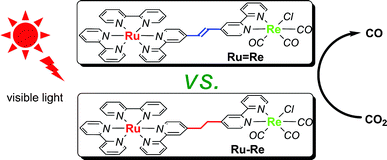Conjugation effect of the bridging ligand on the CO2reduction properties in difunctional photocatalysts†
Abstract
The photocatalytic activity for CO2 ![[double bond, length as m-dash]](https://www.rsc.org/images/entities/char_e001.gif) Re, dmb =
Re, dmb =

* Corresponding authors
a
Laboratory of Organic Optoelectronic Functional Materials and Molecular Engineering, Technical Institute of Physics and Chemistry, Chinese Academy of Sciences, Beijing, P. R. China
E-mail:
bzy@mail.ipc.ac.cn, fwf@mail.ipc.ac.cn
Fax: 86-10-6255-4670
b Yunnan Normal University, Kunming, P. R. China
The photocatalytic activity for CO2 ![[double bond, length as m-dash]](https://www.rsc.org/images/entities/char_e001.gif) Re, dmb =
Re, dmb =

 Please wait while we load your content...
Something went wrong. Try again?
Please wait while we load your content...
Something went wrong. Try again?
Z. Bian, S. Chi, L. Li and W. Fu, Dalton Trans., 2010, 39, 7884 DOI: 10.1039/C0DT00310G
To request permission to reproduce material from this article, please go to the Copyright Clearance Center request page.
If you are an author contributing to an RSC publication, you do not need to request permission provided correct acknowledgement is given.
If you are the author of this article, you do not need to request permission to reproduce figures and diagrams provided correct acknowledgement is given. If you want to reproduce the whole article in a third-party publication (excluding your thesis/dissertation for which permission is not required) please go to the Copyright Clearance Center request page.
Read more about how to correctly acknowledge RSC content.
 Fetching data from CrossRef.
Fetching data from CrossRef.
This may take some time to load.
Loading related content
